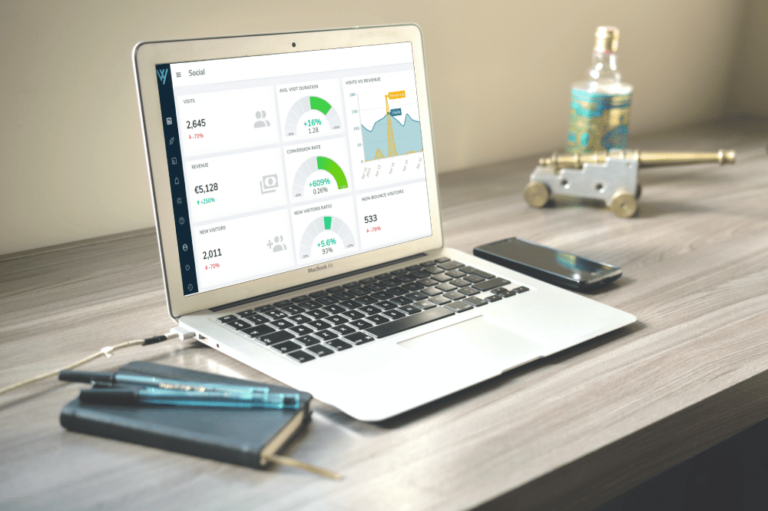These days, businesses heavily rely on online advertising to reach their target audience and drive conversions. Among the various advertising platforms available, Google Ads has emerged as a dominant force, offering powerful features for businesses to promote their products or services. However, choosing the right attribution model within Google Ads is a critical decision that can significantly impact the success of advertising campaigns.
Attribution models play a vital role in determining how credit for conversions or sales is assigned to different touchpoints along the customer journey. In Google Ads, two commonly used attribution models are Data-Driven Attribution and Last-Click Attribution. While both models have their own merits, they differ in their approach and effectiveness in measuring advertising impact.
Throughout this discussion, we will touch upon key topics such as Google Analytics, the importance of data-driven attribution, the role of Google’s machine learning in the data-driven model, and how data-driven attribution allows for conversions based on how people interact with advertisements. So, let’s delve into this comparison and uncover the insights that will help marketers navigate the complexities of attribution within Google Ads.
Data Driven Attribution

Data-driven attribution is a machine learning model that uses conversion data to analyze and assign credit to the touchpoints that led to a conversion. Unlike the default last click attribution model in Google Ads, DDA takes into account all the touchpoints a customer interacts with before making a conversion.
Indeed, Data-Driven Attribution (DDA) marks a significant shift from more traditional attribution models, such as the last-click attribution, which gives all credit for a conversion to the last touchpoint before conversion. This model may not accurately reflect the contribution of earlier marketing efforts in the consumer’s journey toward a conversion. DDA, on the other hand, offers a more holistic view by analyzing the entire conversion path, recognizing and valuing the contribution of each touchpoint in the journey.
Advantages of (DDA) Data-Driven Attribution Model
The power of DDA lies in its use of machine learning algorithms, which sift through a company’s conversion data. These algorithms look at various touchpoints, including clicks on ads, organic search results, social media interactions, and direct website visits, to name a few, considering the sequence and frequency of these interactions.
By analyzing this data, DDA models can discern patterns and assess the impact of each interaction on the likelihood of a conversion occurring. Data-driven attribution offers several advantages over traditional last-click attribution.
- Improved ROI: By understanding which touchpoints truly drive conversions, marketers can allocate their budgets more effectively toward the channels and strategies that work best.
- Holistic Marketing Insights: These are enhanced by the integration of model comparison techniques, which can assess the effectiveness of AdWords and other platforms in a comprehensive marketing strategy. It provides insights into the customer journey as a whole, rather than attributing success to the last interaction. This can help in optimizing the marketing funnel at every stage.
- Better Customer Understanding: DDA helps understand the behavior and preferences of the customers, enabling more accurate targeting and personalization strategies.
- Fair Attribution: It ensures a fair distribution of credit among various marketing efforts, thereby helping to optimize the marketing mix across channels.
Limitations of Data-Driven Attribution
While data-driven attribution is a powerful tool, it does have some limitations. One limitation is the need for a sufficient amount of conversion data to generate reliable results. If a campaign has a limited number of conversions, the data-driven attribution model may not be as effective.
Additionally, data-driven attribution requires ongoing monitoring and adjustments to ensure its accuracy and effectiveness. Indeed, data-driven attribution (DDA) is a cutting-edge approach in marketing analytics that apportions credit to different touchpoints along the customer journey.
Despite its advantages, including providing a more nuanced understanding of how various marketing efforts contribute to conversions, there are several inherent limitations. Let’s delve into these limitations in more detail:
- Data Volume Requirement: As highlighted, DDA models necessitate a substantial amount of conversion data to produce reliable and actionable insights, due to minimum data requirements ensuring the default data-driven methodology’s effectiveness. This requirement often puts smaller businesses or campaigns with lower conversion rates at a disadvantage since they may not generate enough data to accurately train the model.
- Complex Implementation and Maintenance: Setting up and maintaining DDA models can be technically complex. Businesses need access to sophisticated analytics tools and personnel with the expertise to manage and interpret these models properly. This can be a significant barrier for smaller organizations or those without dedicated data science teams.
- Data Privacy Regulations: With the increasing implementation of data privacy laws (like GDPR in Europe and CCPA in California), collecting and processing user data has become more challenging. These regulations can limit the amount and type of data that can be used for DDA, potentially impacting the model’s performance.
- Attribution Window Limitations: These can obstruct the accurate assignment of credit for a sale, especially when not considering every interaction made with Google Ads. The effectiveness of DDA can also be influenced by the chosen attribution window—the period during which conversions are tracked after an interaction. If the window is too short, it may not capture delayed conversions effectively. Conversely, a too-long window might attribute credit to touchpoints that have minimal actual impact on the conversion, challenging the allocation of credit for a sale in a precise manner.
- Inability to Account for External Factors: While DDA is proficient at analyzing the online interactions it has data for, it may not adequately account for offline factors or broader market conditions impacting consumer behavior. For example, a significant brand scandal or a global event could influence conversions but wouldn’t necessarily be reflected in the model.
- Reliance on Historical Data: DDA models are fundamentally predictive, based on past interactions and conversions. This new model comparison offers insights into the effectiveness of different attribution strategies. As markets, technologies, and consumer behaviors evolve, historical data might not always be a reliable indicator of future outcomes. This means models need continuous updates and validation to remain effective.
- Cross-Device and Cross-Channel Tracking Challenges: Despite advancements in analytics technology, accurately tracking users across multiple devices (e.g., mobile phones, tablets, laptops) and channels (e.g., online, offline) remains a challenge. Disjointed user journeys can lead to incomplete data, affecting the attribution model’s accuracy.
Last-Click Attribution

Last-Click Attribution is an attribution model that gives credit for a conversion to the last touchpoint a user interacted with before making a purchase. In other words, it attributes the entire conversion value to the last click or ad interaction. This model is widely used because it is simple to implement and understand. By focusing on the final touchpoint, it allows advertisers to easily track the effectiveness of their campaigns and allocate budget accordingly.
What is Last-Click Attribution?
Last-Click Attribution is a marketing analytics model that assigns credit for a conversion to the last click or ad interaction a user made before converting. It assumes that the last touchpoint significantly influenced the decision to convert and disregards the role of previous touchpoints. In the context of Google Ads, a last-click attribution model means that the last ad clicked by the user will receive 100% of the credit for the conversion.
Advantages of Last-Click Attribution
Last-Click Attribution has its advantages. One of the main benefits is its simplicity. This model provides a straightforward way to measure the success of different marketing channels and campaigns. It allows advertisers to easily identify which ads or keywords are driving the most conversions.
Additionally, last-click attribution helps with budget allocation by showing which touchpoints are more likely to result in a conversion, enabling advertisers to optimize their spending based on these insights.
Indeed, Last-Click Attribution comes with several advantages that make it appealing, particularly for those seeking a clear and uncomplicated approach to understanding marketing performance. Some of these advantages include:
- Simplicity and Ease of Understanding: The main allure of Last-Click Attribution is its simplicity. It credits the final touchpoint before a conversion, making it easy for marketers and advertisers to understand which channels or campaigns drove the sale or lead. This straightforward approach is particularly appealing to businesses with limited resources for analytics or those new to digital marketing.
- Clear Decision-Making for Budget Allocation: When the last click is identified as the primary driver for conversions, businesses can more easily decide where to allocate their marketing budget. This decision-making process, however, could benefit from integrating Google Ads attribution for a fuller view. If a particular channel or campaign consistently appears as the last click before conversion, it signals that investing more in that area could yield more conversions, making budget decisions clearer and possibly improving ROAS if analyzed through Google Ads attribution metrics.
- Facilitates ROI Calculation: By identifying the direct source of conversions, Last-Click Attribution simplifies the process of calculating the return on investment (ROI) for specific marketing efforts. However, incorporating a default data-driven approach could provide a more nuanced ROI analysis. This is invaluable for marketers looking to report on the performance of their campaigns and justify marketing spend.
- Useful for Bottom-of-Funnel Optimization: For campaigns aimed at consumers who are at the bottom of the sales funnel and ready to make a purchase, Last-Click Attribution can provide valuable insights. It helps in understanding which campaigns or channels are effectively sealing the deal, allowing marketers to fine-tune their strategies in the final stages of the consumer journey. This is crucial for maximizing ROAS (Return On Ad Spend) in platforms like Google Ads.
- Benchmarking and Performance Tracking: Even with its limitations, Last-Click Attribution serves as a useful benchmarking tool. It allows marketers to track performance over time, comparing how different channels and campaigns perform in driving final sales or leads. This can be particularly useful in industries where the last interaction is highly indicative of purchase intent.
- Quick Implementation: Due to its straightforward nature, Last-Click Attribution models are relatively easy to implement within most analytics tools. However, transitioning to a default data-driven model might necessitate navigating due to minimum data requirements. This ease of setup makes it an accessible option for many businesses seeking to understand their marketing performance without significant technical development.
Limitations of Last-Click Attribution
While Last-Click Attribution has its merits, it also has limitations. One major limitation is that it overlooks the influence of touchpoints that occurred before the last click. It fails to consider the entire customer journey and the contribution of earlier interactions in the conversion process. This can lead to an incomplete understanding of how customers engage with a brand and make purchase decisions, particularly when not accounting for how consumers interact with your ads across different channels.
Another drawback is that last-click attribution may disproportionately credit certain marketing channels or ads, potentially undervaluing others that played a significant role in the customer’s decision-making process.
The limitations of Last-Click Attribution highlight a significant gap in the evaluation of marketing efficacy, especially in the complexity of modern consumer behavior and digital marketing landscapes. Let’s dive deeper into these constraints and their implications:
- Overlooks the Customer Journey: One of the most critical limitations is the disregard for the customer journey that precedes the final conversion action. Modern customers often interact with a brand through multiple touchpoints—be it social media ads, email marketing, search ads, or content marketing—before making a purchase. By attributing the conversion credit solely to the last interaction, businesses miss out on understanding the multifaceted nature of the customer journey and the interplay of various marketing efforts.
- Misallocation of Marketing Resources: Since Last-Click Attribution can significantly skew toward certain channels, there’s a risk of misallocating marketing budgets and resources. For example, if display advertising often serves as an initial discovery touchpoint but rarely is the last click before a conversion, its value might be underappreciated, leading to underinvestment in this area. Conversely, channels more likely to be credited with the last click, such as branded search, might receive more investment than warranted. This misallocation can result in less efficient marketing spending and strategy.
- Undervalues Upper-Funnel Marketing Activities: Marketing activities that aim to raise awareness and consideration (upper-funnel activities) are crucial in guiding the customer toward conversion. However, Last-Click Attribution inherently undervalues these efforts, as it attributes success exclusively to lower-funnel activities that closer precede a sale or conversion. This undervaluation can lead companies to underestimate the importance of brand-building and awareness campaigns, potentially harming long-term brand equity and customer relationship building.
- Difficulty in Assessing Multi-Device and Omni-Channel Impact: In a world where consumers frequently switch between devices and engage with brands across various channels, Last-Click Attribution falls short. It struggles to accurately attribute conversions that involve multiple devices or cross-channel journeys. For example, a consumer might discover a product through an ad on their mobile phone, conduct further research on a desktop, and eventually make a purchase via a tablet. Last-Click Attribution would only credit the final interaction, neglecting the crucial roles played by other devices and channels.
- Fosters a Short-Term Mindset: The emphasis on the last interaction can foster a short-term marketing mindset, where the focus is on tactics that drive immediate conversions rather than building a sustainable and holistic marketing strategy. This approach can lead to overlooking important long-term objectives like brand loyalty, customer lifetime value, and the overall brand experience.
- Alternatives and Solutions: Recognizing these limitations, many businesses and marketers are shifting towards more nuanced and holistic attribution models, such as multi-touch attribution, which assigns credit to multiple touchpoints along the customer journey. Advanced analytical tools and techniques, such as data-driven attribution, use machine learning algorithms to assign conversion credit in a way that more accurately reflects the contribution of each touchpoint.
What challenges might an advertiser face when switching from last click to data-driven attribution?
When switching from last click to data-driven attribution, advertisers might face challenges such as adjusting to a new way of analyzing performance data, understanding the data-driven model’s reported conversions, and recalibrating their ad strategy based on new insights. It may also require educating teams about the benefits of a multidimensional view of the conversion path provided by data-driven attribution and how it aligns with business goals more effectively.
Comparison and Importance of Attribution Models in Google Ads

Data-driven attribution uses machine learning algorithms to analyze conversion data and assigns credit to all touchpoints along the customer journey, rather than just the last click. It takes into account the influence of each touchpoint and provides a more accurate representation of the customer’s conversion path.
Last-Click Attribution, on the other hand, attributes the entire conversion value to the final touchpoint, disregarding the impact of earlier touchpoints. Attribution models in Google Ads provide marketers with insights into how various touchpoints influence consumers’ paths toward conversions.
By analyzing these interactions, businesses can understand and optimize their marketing strategies for better ROI. The comparison between Data-Driven Attribution (DDA) and Last-Click Attribution (LCA) models highlights the importance of selecting an appropriate model based on campaign goals and data availability.
Default Attribution Model in Google Ads

Understanding the Default Last-Click Attribution Model in Google Ads
Google Ads defaults to using the last-click attribution model, which assigns conversion credit solely to the last touchpoint before a conversion. Essentially, this means that the final ad clicked or interaction made by the user is given complete credit for the conversion. This attribution model is straightforward, allowing for easy measurement of the effectiveness of different marketing channels and campaigns. However, it overlooks the impact of previous touchpoints in the customer journey.
To address this, you can implement conversion tracking and consider switching to a different attribution model, such as data-driven attribution (DDA). By using DDA, credit for conversions is determined based on the various ways people search for your business. It takes into account multiple touchpoints along the customer journey, providing a more comprehensive view of conversion performance.
This approach allows you to give credit to the marketing efforts that contribute to the conversion rather than solely relying on the last interaction. It can be particularly useful for different conversion types, including shopping, by analyzing the role of each touchpoint in driving conversions. To utilize DDA or other attribution models, you can configure your Google Ads account accordingly.
Why the Default Model May Not Be the Best Choice?
While the default last-click model has its advantages, it may not provide a complete understanding of the customer journey and the effectiveness of your campaigns. It overlooks the influence of touchpoints that occurred before the last click, potentially undervaluing their contribution. This can lead to an incomplete view of customer engagement and purchase decisions. It is crucial to explore alternative attribution models, such as data-driven attribution, to gain a more accurate understanding of your campaign’s performance and optimize your advertising strategy accordingly.
Utilizing Machine Learning in Attribution Models

The use of machine learning in attribution models has revolutionized the way marketers analyze and understand customer journeys. By leveraging data-driven attribution models, advertisers can gain valuable insights into the effectiveness of their campaigns and optimize their advertising strategies accordingly.
How Machine Learning Enhances Data-Driven Attribution Models?
Machine learning algorithms play a key role in enhancing data-driven attribution models. These algorithms analyze conversion data and assign credit to various touchpoints based on their importance and impact. By considering all touchpoints along the customer journey, machine learning enables a more accurate and comprehensive understanding of how each step contributes to a conversion. This comprehensive view is central to the data-driven model comparison.
Potential Advantages and Disadvantages of Machine Learning in Attribution
The use of machine learning in attribution models offers several advantages. Firstly, it provides marketers with a more accurate and reliable understanding of the customer journey. By taking into account all touchpoints, including those previously undervalued by traditional models, machine learning ensures that credit is assigned appropriately to each step in the conversion path. This enables advertisers to make data-driven decisions and optimize their campaigns effectively.
However, machine learning in attribution models also has its limitations. One limitation is the need for a sufficient amount of conversion data to generate reliable results. Additionally, ongoing monitoring and adjustments are required to ensure the accuracy and effectiveness of the model.
Conclusion

Choosing the Right Attribution Model for Your Advertising Goals
When it comes to choosing the right attribution model for your advertising goals, it’s important to consider the complexity of your customer journey and the level of granularity you require in your analysis. If you have a short and straightforward conversion path, the last-click attribution model may suffice. However, for businesses with complex customer journeys and multiple touchpoints, data-driven attribution models, enhanced by machine learning, offer a more comprehensive view and valuable insights for optimizing advertising efforts.
Considering the Power of Data-Driven Attribution Vs. Last-Click
While last-click attribution provides simplicity and easy tracking of campaign effectiveness, data-driven attribution models provide a more accurate and comprehensive understanding of the customer journey. By considering the influence of all touchpoints, data-driven attribution ensures that every step of the conversion path receives proper credit. This allows advertisers to make more informed decisions and allocate their budget more effectively based on reliable data.
Are you ready to elevate your attribution strategy? Reach out to Wizaly to learn how our advanced platform can set your company on a road to customer acquisition success!
Key Takeaways:
- Amount of data: Data plays a crucial role in understanding customer behaviors and optimizing advertising strategies.
- Make the switch: Consider transitioning from Last Click attribution to Data Driven Attribution for more accurate credit allocation.
- Attributes credit for your conversions: Data Driven Attribution assigns credit to various touchpoints along the customer journey, giving a holistic view of the conversion process.
- Credit for your conversions based: Data Driven Attribution assigns credit based on multiple factors, such as ad interactions, keywords, and user behavior.
- The model works: Data Driven Attribution utilizes machine-learning models to analyze large volumes of data and derive meaningful insights.
- Based on how people search: Data Driven Attribution takes into account how individuals search and interact with your ads to understand their contributions to conversions.
- Help you make: Data Driven Attribution provides valuable insights that can guide decision-making and optimize advertising campaigns.
- Account to determine: Your Google Ads account can determine the attribution model that best suits your business goals and objectives.
- Determine which keywords: Data Driven Attribution helps identify the keywords that have the most impact on conversions, allowing for better optimization.
- Business and interact: Data Driven Attribution allows businesses to understand how customers interact with their ads, helping improve overall marketing strategies.
- Machine-learning: Machine-learning algorithms are utilized in Data Driven Attribution to analyze and make sense of large amounts of data, enabling accurate attribution.
- Ad-types: Data Driven Attribution considers different ad types to evaluate their effectiveness in driving conversions, enabling optimization based on ad performance.



